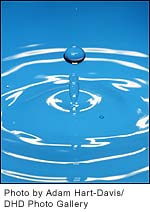 Managing water shortages under a growing population
Managing water shortages under a growing population
A new study has analysed water shortages around the world over the past two millennia. Population growth has been a significant pressure on supplies and will continue to increase in threat in future. Dealing with water scarcity will therefore increasingly require improved water governance, management and policy measures, which are fully integrated into societal development.
The researchers examined the long-term trends in water shortages from the year 0 AD to 2005 AD using climate and hydrological modelling of water balance in river basins. The results provided a picture of water shortages over 12 regions across the world in relation to population growth.
Overall, the study found that changes in population growth on water shortages were four times more significant than the impact of climate change. Water shortages first developed around 1800, when about 5 per cent of the world population (about 40 million people) lived under moderate water shortage, i.e. there were 1000-1700 cubic metres of water available for each person every year (m3/capita/yr).
From 1900 onwards, the number of people living under water shortage conditions increased sharply: by 1960, 280 million people, or 9 per cent of the global population were living under chronic water shortage (less than 1000 m3/capita/yr). In 2005 about half the worlds population, or about 3 billion people, were living with some form of water shortage, of which 2.3 billion (or 35 per cent) were living under chronic water shortage.
Some regions have particularly serious water shortage problems. By 2005, South Asia was the region with the highest percentage (95 per cent) of people living under some form of water shortage (less than 1700 m3/capita/yr). In North Africa this figure was 81 per cent and 76 per cent in the Middle East. The annual population growth in these regions is over 2 per cent and will probably lead to further water shortages.
The most severe water shortages occur in North Africa and the Middle East, where more than half of the population live under extreme water shortage (less than 500 m3/capita/yr).
Throughout history, people have used a number of adaptation measures in response to water shortages. During the 20th century, the three most common strategies have been to construct dams and reservoirs to store water, to irrigate crops in low rainfall areas, and to withdraw groundwater in areas where there is little fresh water. In addition, global trade in agricultural products can help alleviate water shortages, as areas with inadequate water resources import crops grown in regions with sufficient water.
Nevertheless, structural adaptation measures alone are not enough to combat physical water scarcity in the future. 'Soft' adaptation measures (non-structural) are increasingly an essential component of water management, and include increasing the efficiency of water use, reducing the intensity of water use, the pricing of water services, recycling water, improving water distribution networks and improving water irrigation technologies. For these strategies to contribute to water security, water governance, management and policies must be fully integrated into a society's political, social and economic development.
| Contact information |
Kummu, M., Ward, P.J., de Moel, H., and Varis, O. (2010) Is physical water scarcity a new phenomenon? Global assessment of water shortage over the last two millennia. Environmental Research Letters. 5: 034006 (10pp).
(email: carolina@ppe.ufrj.br; philip.ward@ivm.vu.nl; hans.de.moel@ivm.vu.nl; olli.varis@tkk.fi ) |
|---|---|
| News type | Inbrief |
| File link | n/a |
| Source of information | Science for Environment Policy, issue 220: a service from the European Commission |
| Keyword(s) | Sustainable development and policy analysis, water shortages |
| Subject(s) | FINANCE-ECONOMY , HYDRAULICS - HYDROLOGY , METHTODOLOGY - STATISTICS - DECISION AID , POLICY-WATER POLICY AND WATER MANAGEMENT , RISKS AND CLIMATOLOGY , WATER DEMAND |
| Relation | http://www.semide.org/topics/WaterScarcity |
| Geographical coverage | n/a |
| News date | 07/12/2010 |
| Working language(s) | ENGLISH |
 you are not logged in
you are not logged in





